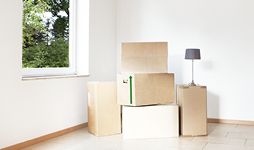Home insurance can be confusing, especially if you’re trying to get to grips with all the jargon. It’s important to understand what these terms mean to ensure you have the right cover for your home. But fear not! We're here to help make things simpler with our alphabetically listed jargon buster.

A:
ABI (Association of British Insurers)
Insurance companies, like MORE THAN, become members of this organisation to understand all changes in the insurance industry. For example, regulatory or government policy changes.
Accidental damage cover
Accidental damage covers your buildings, contents or both against unintentional damage at home. This includes things like dropping your mobile, spilling wine over your carpet or unintentional damage to your TV
Act of God
An accident or event that can’t be prevented by human foresight, like the weather.
Add-ons, ancillaries, optional extras/cover
These can be added to your home insurance to give you extra cover, like accidental damage or home emergency cover.
Alternative accommodation
This cover can help if you're no longer able to live in your home due to damage covered by your policy. If this happens, your insurer will pay up to a specified amount for you and your family to stay somewhere else.
Amendment
A change to your home policy, like a change of name or address.
Annual premium
A single one-off payment you make for your home cover.
B:
Buildings insurance
Covers the cost of repairs to the structure of your home when it's damaged by an insured event. From fires and theft to storms and flooding.
The structure of your home includes:
- Walls, roof and windows
- Kitchen and bathrooms
- Conservatories
- Garages, sheds and other outbuildings, including summer houses
- Drives and patios
Building sum insured
The amount of cover that helps towards the cost of repairing or rebuilding the structure of your home.
C:
Cancellation fee
If you decide to cancel your home policy after the cooling-off period (usually 14 days after you take out your policy) you may have to pay a fee to your insurers.
Claim - fault claim and no-fault claim
A claim is a request a policyholder makes to an insurer to repair, replace or compensate for a loss.
- Fault claim is, for example, if you’ve done something, like putting your foot through the ceiling when in the loft. This could be an accidental damage claim.
No-fault claim is if someone or something else has caused damage, such as storm damage.
Claim history
Information about any claims you’ve made. When you get a quote, insurers normally ask if you’ve made a claim in the last 3 to 5 years.
Contents
Items in your home that are moveable, such as a TV, sofa or clothes.
Contents insurance
Covers the items in your home that could be taken with you if you moved house. Like furniture, televisions, laptops, jewellery and clothing.
We'll pay to repair or replace the contents of your home if they're lost, stolen, or damaged by something covered by your policy. For example, a flood or fire.
Contents sum insured
The amount of cover that goes towards the cost of replacing your belongings if damaged or lost.
This cover isn't automatically included as part of your home insurance policy. As a result, you may have to add optional cover, like personal possessions.
Combined policy
Covers your home and its contents on one policy. You can buy buildings and contents insurance cover separately.
Cooling-off period
The time after you take out your home policy when you can usually cancel without a fee. This is often 14 days after you take out your policy.
For MORE THAN renewals, the cooling-off period is 14 days from the renewal date. Once we receive your cancellation request, we'll refund any payments unless you’ve made a claim in the current period of insurance.
E:
Escape of water
Escape of water is a water leak. For example, if a water pipe bursts.
Excess – compulsory and voluntary
The amount you’ll have to pay towards a claim.
Compulsory excess - for some claims, you need to pay a compulsory or fixed excess. This is a fixed amount you’ll pay to make a claim.
For escape of water, subsidence or accidental damage claims, you only pay a fixed excess which is usually higher than a standard compulsory excess.
Voluntary excess - you can choose to pay a higher or lower excess which may impact your price. This is called voluntary excess.
For most claims, you'll have to pay the voluntary and compulsory excess when making a claim.
Exclusions
Something that isn't included or covered in your policy.
F:
FLEA cover
When insurers don’t offer a standard house insurance level of policy cover for unoccupied premises, they may offer what is known as FLEA cover.
This is a restricted type of cover and stands for:
- Fire
- Lightning
- Explosion
- Aircraft cover
This may also include Earthquake cover, but the acronym FLEA is not always used.
If you’re offered FLEA cover, you should check exactly what you’re covered for.
Food in the fridge and freezer
Cover for the contents of your freezer. Contents of fridges are sometimes covered too. Insurers will pay up to a set limit to replace food spoiled because of a breakdown or power cut. With MORE THAN Standard or Extra cover, you'll get up to £1,000 to replace fridge and freezer food. If you have a existing MORE THAN policy with policy number starting HI you'll be covered up to £500 to replace fridge and freezer food.
G:
Garden cover
Garden insurance covers your garden items against loss, damage and theft. This includes items you might leave out in the open, like garden furniture and children's toys. It often includes damage and loss to your plants, trees and shrubs. You may need to add garden cover onto your home insurance as it isn't always included as standard.
Good state of repair
Items that are in a good condition or well looked after.
H:
Heave
When the soil beneath your home expands and pushes the ground upwards, sometimes causing structural damage to a building. Ground heave is the opposite of subsidence, which is when the ground sinks.
Home emergency cover
This is usually an additional cover that you can choose to add to your policy. Home emergency covers you if something happens that makes your home unsafe, insecure or which might cause more damage to your home or contents. Learn more about our home emergency cover options.
I:
Insured events
An event that causes an insurer to pay a claim.
J:
Joint proposer or joint policyholder
When two people, like a couple, both want to insure a property. Both parties can speak to the insurer and manage the policy.
L:
Legal protection/Legal expenses cover
Our legal services cover offers help if you've got a problem and want to know more about your rights or legalities of a situation.
Listed building
A building with special architectural and historic interest. Planning and change restrictions will be in place on the property so that it can be protected for future generations. The older a building is, and the fewer surviving examples of its kind, the more likely it is to be listed.
M:
Matching sets
If part of a matching set, for example a sofa, is damaged and can’t be repaired, we’ll try to replace the whole matching set. Not all insurers offer this cover option.
Moneyfacts
Moneyfacts gives independent reviews on banking and insurance products. They are authorised and regulated by the Financial Conduct Authority (FCA).
Mortice lock
A lock fitted into a hole in a door. Mortice means a hole in the door where the lock is fitted. Read our guide about door security.

N:
New for old
New for old cover is included as standard on most home insurance policies. It means if an item is damaged beyond repair, lost or stolen your insurer will try and replace it with a new like-for-like item. For example, if your TV is stolen, we'll try and replace it with the same make or model – or similar if the item is no longer available.
Some insurers will give you the cash value so you’re able to buy a replacement, which often works out quicker.
Exclusions apply. See our policy wording for more information.
Non-standard construction
A building built from materials that are defined as not standard. Standard houses have brick or stone walls with a roof made of slate or tile. MORE THAN classifies non-standard construction as anything that falls outside this, like a thatched roof.
Non-specified items
These are items that you don’t have to tell us about.
P:
Personal possessions
Covers your everyday belongings against accidental loss or damage in and outside the home. This includes mobile phones, laptops, clothing, cash, jewellery, musical instruments and sports equipment.
It's an optional add-on that you can buy with, or add to, your contents insurance policy
Policy
A document that has information about the terms and conditions of a contract of insurance.
Policy limits
The maximum amount an insurer will pay out on a claim.
Policyholder
The person named on the policy and who has a financial interest in the insured home or contents.
Premises
A house or building, including its land and outbuildings, occupied by a business or individual.
Premium
The amount you pay for your insurance cover.
R:
Re-build cost
The cost to rebuild your property.
The Royal Institution of Chartered Surveyors (RICS) has a useful calculator to work out the rebuilding costs of your home using the Building Cost Information Service (BCIS) guide.
Rental contents insurance
Cover for people who rent and want to insure their belongings against loss, theft or damage.
Risk
A situation where there’s exposure to danger. Insurers see this as the chance of you making a claim. For example, if you live somewhere that has a high number of burglaries.
S:
Sanitary fittings
Bathroom fixtures like a toilet and sink.
Settlement
How much an insurer will pay out in the event of a claim.
Schedule or Schedule of Insurance
A list explaining key terms, optional cover options, exclusions and limitations of an insurance policy.
Single article limit (SAL)
Often known as a single article limit or sum insured. This is the most you can claim on your contents cover for a single item.
If any of your items over this limit are damaged, lost, or stolen, then we may not cover you for their full value. We include items like jewellery and laptops within the limit. See specified items.
Subsidence
The gradual sinking of the ground under your property. Subsidence can be expensive to fix so it's worth making sure your insurance covers this.
Subsidence excess
The amount you pay if you had to make a subsidence claim. This is often higher and differs to your standard excess.
Sum insured
The maximum amount of money an insurer will pay in the event of loss.
Specified items
These are items worth over the single article limit. You may need to tell your insurer about these items separately to ensure you have the right cover if anything happens to them. At MORE THAN, you need to tell us about items worth over £2,000, whether you take them outside the home or not.
T:
Tenure
Ownership of a property – either mortgaged, rented or owned outright.
Trace and access
The cost of removing and replacing part of the building to repair a heating or water system after a water or oil leak.
For example, you have a burst water pipe behind a wall or underneath your flooring, and we need access to fix the problem. We’ll repair the floor or wall where we accessed the leak after it's been fixed.
With our home insurance, you’ll get up to £1,000 cover with our Essentials cover, up to £2,500 with Standard and up to £5,000 if you choose Extra.
U:
Underpinning
A solid foundation laid below ground level to support or strengthen a building. This is usually done on properties which have suffered subsidence.
Under-insured
Inadequate insurance cover. In the event of a claim, underinsurance may result in not having enough to replace all of your items.
Uninsured losses
A loss at your home that’s not covered by your insurance.
Unoccupied
Your property is not lived in or vacant. If your property is left vacant for over a certain number of days, your insurance won’t be valid, or insurers may not pay out for a claim. With MORE THAN policies, your home shouldn’t be unoccupied for over 60 days.
V:
Valuables
Jewellery, watches and items containing gold, silver or platinum. These are valuables in the home that are seen as more likely to be stolen in the event of a burglary.
W:
Wear and tear
The gradual deterioration of your belongings (contents) or structure of the home. This includes things like fading curtains, draughty windows or the breakdown of household appliances, such as a washing machine.
Y:
Year built
When the property was originally built. Insurers usually need the year you state to be within a range of 10 years. You can find details in your household deeds or, if you rent, ask your landlord.
Didn't find what you were looking for?
We hope we've helped bust some home insurance jargon for you, but if there's anything you're still unsure of, you can contact us.



